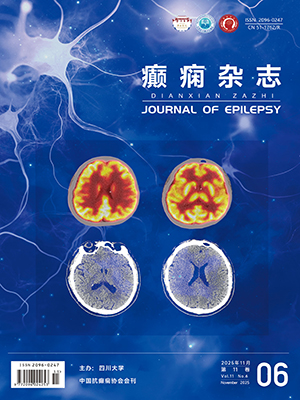| 1. |
He N, Min FL, Shi YW, et al. Cutaneous reactions induced by oxcarbazepine in Southern Han Chinese: Incidence, features, risk factors and relation to HLA-B alleles. Seizure, 2012, 21(8): 614-618.
|
| 2. |
中華醫學會神經病學分會腦電圖與癲癇學組. 抗癲癇藥物應用專家共識. 中華神經科雜志, 2011, 44(1): 56-65.
|
| 3. |
Toledano R, Gil-Nagel A. Adverse effects of antiepileptic drugs. Semin Neurol, 2008, 28(3): 317-327.
|
| 4. |
Shi YW, Min FL, Zhou D, et al. HLA-A*24: 02 as a common risk factor for antiepileptic drug-induced cutaneous adverse reactions. Neurology, 2017, 88(23): 2183-2191.
|
| 5. |
Roujeau JC. Clinical heterogeneity of drug hypersensitivity. Toxicology, 2005, 209(2): 123-129.
|
| 6. |
柴長鳳, 胡瑞宏, 畢曉瑩. 奧卡西平藥物基因組學研究進展. 世界臨床藥物, 2018, 39(12): 850-855.
|
| 7. |
盛琳琳. 奧卡西平與卡馬西平治療成人部分性癲癇的效果比較. 中國當代醫藥, 2021, 28(3): 102-105.
|
| 8. |
雷婧, 謝婷, 南慶玲, 等. 新型與傳統抗癲癇藥物對新診斷癲癇患兒的療效及安全性分析. 中國醫藥, 2020, 15(7): 1106-1110.
|
| 9. |
吳思凡, 譚長宇, 樊紅彬, 等. 奧卡西平和卡馬西平治療腦卒中后繼發性癲癇療效與安全性的Meta分析. 藥學實踐雜志, 2018, 36(4): 373-378.
|
| 10. |
民福利, 王曉, 范翠霞, 等. 奧卡西平導致的皮膚不良反應與HLA-B~*1502、HLA-B~*1301基因的關系. 實用醫學雜志, 2021, 37(16): 2080-2083+2088.
|
| 11. |
Shi YW, Wang J, Min FL, et al. HLA risk alleles in aromatic antiepileptic drug-induced maculopapular exanthema. Front Pharmacol, 2021, 12: 671572.
|
| 12. |
Arif H, Buchsbaum R, Weintraub D, et al. Comparison and predictors of rash associated with 15 antiepileptic drugs. Neurology, 2007, 68(20): 1701-1709.
|
| 13. |
Alvestad S, Lydersen S, Brodtkorb E. Rash from antiepileptic drugs: influence by gender, age, and learning disability. Epilepsia, 2007, 48(7): 1360-1365.
|
| 14. |
Wang XQ, Lang SY, Shi XB, et al. Antiepileptic drug-induced skin reactions: a retrospective study and analysis in 3793 Chinese patients with epilepsy. Clin Neurol Neurosurg, 2012, 114(7): 862-865.
|
| 15. |
何娜, 民福利, 石奕武, 等. 卡馬西平和拉莫三嗪所致皮疹的臨床特征及危險因素分析. 實用醫學雜志, 2016, 32(22): 3760-3764.
|
| 16. |
黃亞莉, 任惠. 芳香族抗癲癇藥物所致嚴重皮膚不良反應的研究進展. 癲癇雜志, 2017, 3(04): 325-328.
|
| 17. |
石奕武. 芳香族抗癲癇藥物導致皮膚型藥物不良反應與HLA基因的關系進展. 實用醫學雜志, 2012, (13): 2119-2121.
|
| 18. |
Mehta TY, Prajapati LM, Mittal B, et al. Association of HLA-B*1502 allele and carbamazepine-induced Stevens-Johnson syndrome among Indians. Indian journal of dermatology, venereology and leprology, 2009, 75(6): 579-582.
|
| 19. |
Tassaneeyakul W, Tiamkao S, Jantararoungtong T, et al. Association between HLA-B*1502 and carbamazepine-induced severe cutaneous adverse drug reactions in a Thai population. Epilepsia, 2010, 51(5): 926-930.
|
| 20. |
Chang CC, Too CL, Murad S, et al. Association of HLA-B*1502 allele with carbamazepine-induced toxic epidermal necrolysis and Stevens-Johnson syndrome in the multi-ethnic Malaysian population. International journal of dermatology, 2011, 50(2): 221-224.
|
| 21. |
Man CB, Kwan P, Baum L, et al. Association between HLA-B*1502 allele and antiepileptic drug-induced cutaneous reactions in Han Chinese. Epilepsia, 2007, 48(5): 1015-1018.
|
| 22. |
Shi YW, Min FL, Qin B, et al. Association between HLA and Stevens-Johnson syndrome induced by carbamazepine in Southern Han Chinese: genetic markers besides B*1502? Basic Clin Pharmacol Toxicol, 2012, 111(1): 58-64.
|
| 23. |
Chen P, Lin JJ, Lu CS, et al. Carbamazepine-induced toxic effects and HLA-B*1502 screening in Taiwan. N Engl J Med, 2011, 364(12): 1126-1133.
|
| 24. |
Hung SI, Chung WH, Jee SH, et al. Genetic susceptibility to carbamazepine-induced cutaneous adverse drug reactions. Pharmacogenet Genomics, 2006, 16(4): 297-306.
|
| 25. |
Li LJ, Hu FY, Wu XT, et al. Predictive markers for carbamazepine and lamotrigine-induced maculopapular exanthema in Han Chinese. Epilepsy Res, 2013, 106(1-2): 296-300.
|
| 26. |
Shirzadi M, Thorstensen K, Helde G, et al. Do HLA-A markers predict skin-reactions from aromatic antiepileptic drugs in a Norwegian population? A case control study. Epilepsy research, 2015, 118: 5-9.
|
| 27. |
Shi YW, Min FL, Liu XR, et al. HLA-B alleles and Lamotrigine-induced cutaneous adverse drug reactions in the Han Chinese population. Basic Clin Pharmacol Toxicol, 2011, 109: 42-46.
|
| 28. |
Alfirevic A, Jorgensen AL, Williamson PR, et al. HLA-B locus in Caucasian patients with carbamazepine hypersensitivity. Pharmacogenomics, 2006, 7(6): 813-818.
|




